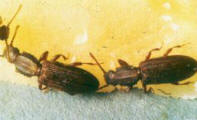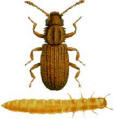
- Flattened, reddish-brown, and about 1/10-inch long.
- Six saw tooth-like projections on each side of the thorax (middle part between the head and the wing covers). Under magnification, the saw toothed grain beetle has exposed eyes.
- Males can be separated from females by observing a tooth on the femur of the hind leg.
- The adult beetles usually deposit their eggs in the food stuffs
they infest. A single female can lay from 45 to 250 or more eggs which
 hatch in 3 to 17 days depending on the temperature.
hatch in 3 to 17 days depending on the temperature. - The larva is yellowish white with a brown head and measures 1/8 of an inch in length when fully grown. The larval period lasts from 2 to 10 weeks after which they pupate by sticking together small bits of the food material to form a protective covering around their bodies.
- The pupal stage lasts from one to three weeks after which the new adults emerge.
- The adults are long-lived and have been kept alive for over 3 years. Under ideal conditions the life cycle is completed in about 4 weeks.
- The eggs are deposited on cracks in grain kernels.
- They can build up to high numbers in stored grain
- Freeze grains, flour, dried fruit and other dry foods from bulk
food stores in the household freezer for a week before transferring the
 products to cupboards
products to cupboards - Store food in insect proof containers of glass or strong plastic with tight-fitting lids, and
- Clean kitchen counters and vacuum the insides of cabinets to remove spills and debris
Sanitation
- Maintaining clean conditions is the best control. In warehouses and bulk storage facilities, products should be stored away from walls to make it easy to clean behind the containers.
- All spills should be cleaned up immediately. Stock should be rotated regularly.
Reduce Humidity
- Grains should be stored in a cool dry area.
- In commercial facilities, ventilation can be increased to reduce the moisture content of the grain.
Barriers
- Insect screens should be installed on ventilators, windows and other openings to keep flying insects out.
- Remove everything from food cabinets and shelves and clean all surfaces by vacuuming to remove all chaff, refuse or food particles from cracks and crevices. Loosen such materials in cracks and crevices with a knife if necessary to aid in removal by vacuum cleaner.
- All food packages should be examined for beetles and infested packages removed and destroyed. Search packages of food rarely used as a possible source of the infestation in the backs of cupboards or drawers.
- Place packaged foods in tight glass, plastic, or metal containers for storage.
- Newly purchased foods should be opened and carefully examined for possible sources of reinfestation.